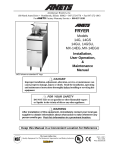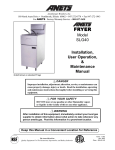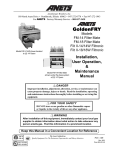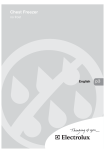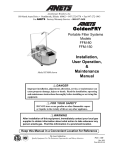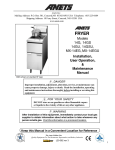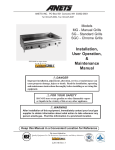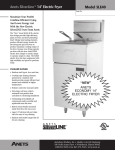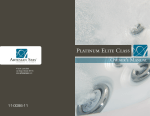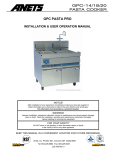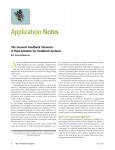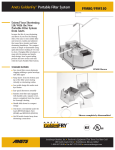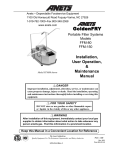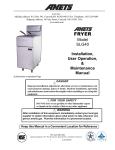Download Anetsberger Brothers CF14 User's Manual
Transcript
Anetsberger Brothers, Inc. 180 North Anets Drive • Northbrook, Illinois 60062 • 847-272-0770 • Fax 847-272-1943 For ANETS Factory Warranty Service • 800-837-2638 FRYER Model CF14 Installation, User Operation, & Maintenance Manual ! DANGER Improper installation, adjustment, alteration, service, or maintenance can cause property damage, injury or death. Read the installation, operating and maintenance instructions thoroughly before installing or servicing this equipment. ! FOR YOUR SAFETY DO NOT store or use gasoline or other flammable vapors or liquids in the vicinity of this or any other appliance. ! WARNING After installation of this equipment, immediately contact your local gas supplier to obtain information about what action to take whenever any person smells gas. Post this information in a prominent location. Keep this Manual in a Convenient Location for Reference The Anets Golden Line Quality Equipment For The Restaurant, Supermarket, and Bakery Industries Form I-152 ; Rev. 12/03 Price: $20.00 US 1 www.anetsberger.com ! DANGER Read these specifications, Code Requirements, Installation Requirements, Installation Instructions, and Operating Instructions very carefully. Failure to follow the Instructions could cause the fryer to malfunction. A fryer malfunction can result in property damage, serious bodily injury, or death. CONTENTS Shipping Container Inspection ........................................................ 3 Fryer Gas Supply Specifications ..................................................... 3 Fryer Electrical Specifications ....................................................... 4 Figure 1 - Fryer Model CF14 Wiring Diagram ....................... 4 Code Requirements ...................................................................... 4 Figure 2 - Fryer Site Installation Requirements ....................... 5 Installation Requirements ............................................................... 5 Leg Leveling Instructions ............................................................... 5 Gas Connection Instructions .......................................................... 6 Fryer Operating Instructions .......................................................... 6 Fryer Preparation For Use (“Boil Out” Instructions) ................ 7 Figure 5 - Draining The Kettle ............................................... 7 Lighting Procedure .................................................................. 8 Figure 6 - Gas Safety Valve & Control Knob Positions .......... 8 Shutdown Procedure .............................................................. 9 Daily Cleaning Procedure ....................................................... 10 Monthly Maintenance Instructions .......................................... 11 Fryer Troubleshooting Guide ................................................... 11-15 Fryer Warranty ............................................................................ 16 2 SHIPPING CONT AINER INSPECTION CONTAINER 1. Carefully examine the shipping carton for external damage. When damage is noted, notify the delivery carrier immediately. Save all packing materials for damage claim examination. 2. If no external damage is noted, remove the shipping carton from the fryer and examine the fryer carefully for damage. Place the fryer in a safe location, if damage is noted, so that the freight damage claims adjuster can examine the fryer. 3. Save the shipping container for use during leg/ caster installation. Refer to the Installation Instructions for that procedure. Model Covered By This Manual CF14 14” Gas Counter Fryer Standard Accessories furnished in the shipping carton for this fryer include: 2 Fryer Baskets 1 Drain Valve Extension 1 Screen 1 Basket Hanger Note: A Parts List for each Anets fryer is among the items shipped with each fryer. If an additional copy of this list is needed please contact the factory as directed on the back cover. FRYER GAS SUPPLY SPECIFICATIONS Please make sure that your desired fryer location has gas supply factors that are suitable for this product: Gas Input: CF14 70,000BTU/Hr* Natural Gas Propane MANIFOLD PRESSURE 3½“ W.C. ** 10“ W.C. SUPPLY PRESSURE*** 6“ W.C., minimum 11“ W.C., minimum * - BTU/Hr Rating is based on sea level operation. For sites above 2000 feet, reduce this rating 4% for each 1000 feet above sea level. ** “W.C. = Inches, Water Column. *** - Measure Supply Pressure when all other gas-powered equipment is operating. Gas Supply Inlet Pipe size must be 1/2“ NPT (National Pipe Thread) standard gas line. The gas supply inlet line should be as straight as possible (fewest bends or elbows) to obtain the highest available gas pressure at the fryer. Locate this inlet line horizontally at the center of the desired fryer location. NOTE: Using a flexible inlet line permits variation in the gas supply line location, both horizontally and vertically. Anets fryers are only for use with the type of gas specified on the spec plate. if a fryer requires modification to use a gas other than that which is identified on the fryer spec plate, contact your Anets representative or call (800) 837-2638. 3 FRYER ELECTRICAL SPECIFICATIONS The ANETS Fryer Model CF14 requires no external electric power source. Figure 1 is a wiring diagram of an ANETS CF14 Fryer. Some fryers may have other options that do not appear in this basic wiring diagram. A model-specific wiring diagram included with each fryer shows all the actual parts and their associated wiring connections. Figure 1. Fryer Model CF14 Wiring Diagram CODE REQUIREMENTS IMPORTANT: Read the Code Requirements and ALL installation instructions carefully, before starting the installation. Contact the factory if any problems or questions arise. The fryer installation must conform with local codes, or in the absence of local codes, with the National Fuel Gas Code, ANSI Z223.1 (latest edition); the Natural Gas Installation Code, CAN/ CGA-B149.1 (latest edition); or the Propane Gas Installation Code, CAN/CGA-B149.2 (latest edition), as applicable, including: a. Disconnect the fryer and its individual shutoff valve from the gas supply piping system during any pressure testing of the gas supply system at test pressures in excess of ½ psig (3.45 kPa). b. Isolate the fryer from the gas supply piping system during any pressure testing of the gas supply system at test pressures equal to or less than ½ psig (3.45 kPa). 4 c. Install this fryer on a non-combustible surface with its back and sides at least 6” away from any combustible wall, as shown in Figure 2. d. Install this fryer in a location where adequate combustion and ventilation air is available. Keep the area directly in front of the fryer open for adequate air flow to the burners. DO NOT obstruct the flow of combustion and ventilation air. h. Keep the fryer area free and clear from combustibles and debris. ! WARNING Install this fryer under a ventilation hood that conducts combustion products outside the building. Venting must comply with ANSI/NFPA 96 (latest edition). Figure 2. Fryer Site Installation Requirements INST ALLA TION REQ UIREMENTS INSTALLA ALLATION REQUIREMENTS Install the fryer in accordance with the preceding Code Requirements, as well as the following Installation Requirements. 1. DO NOT install this fryer in a mobile home, trailer, or recreational vehicle. 2. Install this fryer in a location that allows it to be moved away from other adjacent appliances for cleaning and maintenance. NOTE: If the fryer is installed among a row of appliances where its only convenient movement is forward, sufficient room must be available in front to permit its separation from adjacent appliances for cleaning and maintenance. 3. Confirm that the air from the ventilation hood flowing near the fryer after installation is NOT blowing on the rear of the fryer, to prevent affecting the burner flames and possibly causing control damage. UTION: Hood make-up air CAUTION: ! CA MUST NOT flow in a manner that restricts or impedes the natural flow of combustion or ventilation air. LEG LEVELING INSTRUCTIONS 1. Move the fryer to its desired location. WARNING The fryer MUST NOT tip, rock or wobble, to avoid splashing or spilling its HOT frying fat contents during operation. 2. Turn the screw-type leg adjustment ends as necessary to level the fryer, until no tipping, rocking, or wobbling is evident. 5 GAS CONNECTION INSTRUCTIONS Installing your ANETS Fryer requires the following procedure, after it is in its desired location. 1. Ensure that the gas control valve knob in the fryer has its OFF position next to the valve mark. 2. Ensure that the gas supply inlet line valve is closed (cross-wise to the pipe line direction). 3. Ensure that all fryer controls are set to OFF. 4. Connect the1/2” gas supply line to the gas line adapter on the lower rear of the fryer. 5. Turn the gas supply line valve ON; then, confirm that all gas supply line joints and couplings are free of leaks, using soap suds or a leakcheck solution, after the fryer is in its desired location. ! WARNING DO NOT use a flame to check for leaks. 6. Refer to Fryer Operating Instructions to begin using your ANETS Fryer. FR YER OPERA TING INSTR UCTIONS FRYER OPERATING INSTRUCTIONS ! CAUTION ! DO NOT attempt to operate this fryer during a interruption of gas service. Turn all fryer controls to OFF, including the gas control valve knob, then close the gas supply line valve. When notified that the gas interruption has ended, perform the Lighting Procedure (later in this manual). A. CAUTION: DO NOT melt solid shortening in this fryer because the melting can damage the kettle, which will void the fryer warranty. This ANETS CF14 Fryer is designed for operation with a kettle filled with approximately 30 pounds of liquid shortening. Solid shortening must be melted into the liquid state before it can be used in an ANETS Fryer. ! DANGER Avoid moving the fryer while it contains HOT shortening. Drain the shortening from the fryer before moving it for service, clean- ing or maintenance to avoid spilling or splashing. Burns from hot shortening can cause serious injury or ! DANGER NEVER operate this fryer when its flue is blocked or when the ventilation hood is not on because the combustion products can cause injury to personnel. 6 B. Schedule regular cleaning of the fryer to ensure long-term satisfactory operation. Refer to the Daily Cleaning Procedure, later in this manual. C. Before servicing and maintenance, allow the fryer to cool. ALWAYS shut off the gas to the fryer while working on it, to prevent burns. D. Contact the factory (800-837-2638) for warranty service authorization. [Always notify the factory the next business day about ‘after-hours’ warranty service.] Contact your Anets Authorized Service Agency for other service, repairs, or maintenance activities, as necessary. FR YER OPERA TING INSTR UCTIONS FRYER OPERATING INSTRUCTIONS FRYER PREPARATION FOR USE “BOIL OUT” INSTRUCTIONS New ANETS Fryers are leak-tested and cleaned at the factory before shipping. Before using a newly installed fryer for food preparation, clean the kettle again, as follows: 1. Thoroughly wipe the interior of the kettle with clean cloths. Open the front door on the lower portion of the fryer to access the drain ball valve. Open the drain ball valve (by aligning the valve handle with the drain ball valve) and wipe the entire drain line clean. (Continued) FRYER PREPARATION FOR USE (Continued) 7. Open the front door and mount the drain extension to the drain ball valve. Position a container (bucket) capable of holding VERY HOT cleaning solution beneath the end of the drain extension to hold the cleaning solution being drained, as shown in Figure 5. 2. Close the drain ball valve (turn the valve handle cross-wise to the drain ball valve). Fill the kettle with water to about 3“ from the top. Add 1 to 2 cups of soap powder, washing soda (trisodium phosphate), or deep fat fryer kettle cleaner. 3. Perform the Lighting Procedure for the fryer. (Refer to the Lighting Procedure later in this manual.) 4. Set the thermostat to 190°F. Heat, but DO NOT boil the water. Stir the water to dissolve the cleaning material. ! WARNING Hot cleaning solution can cause severe burns. Take care when handling hot cleaning solution to avoid spilling or splashing the solution. 5. Clean the fryer kettle for at least 20 minutes. Use a small hand mop (an optional brush can be ordered for this purpose) to clean the upper portion of the kettle (above the 3“ waterline) and the top rim of the kettle. 6. Shut down the fryer using the Shutdown Procedure for the fryer. (Refer to the Shutdown Procedure later in this manual.) Allow the water to cool slightly. Figure 5. Draining The Kettle 8. Open the drain ball valve SLOWLY, to avoid splashes while draining the cleaning solution from the kettle. 9. Close the drain ball valve (valve handle crosswise) and remove the drain extension. Close the front door. 10. Safely dispose of the cleaning solution. 11. Fill the kettle with water to about 3“ from the top. Add 2 cups of vinegar to neutralize the cleaning solution. 12. Repeat steps 3 through 10 of this procedure. 13. Thoroughly wipe the interior of the kettle and the drain ball valve with clean, dry, wiping cloths to remove ALL water. 14. Dry the kettle thoroughly because any remaining water can cause sputtering of hot shortening when the kettle is later filled and heated. 7 FR YER OPERA TING INSTR UCTIONS FRYER OPERATING INSTRUCTIONS (Continued) Normal operation of an ANETS Fryer requires that the kettle is filled with liquid shortening above the lower indent level, marked on the rear of the kettle, before lighting the fryer’s pilot and turning on the main burner. ! CAUTION: Shortening MUST be in liquid form to avoid scorching or discoloration and possible damage to the kettle. Damage caused by melting solid shortening will NOT be covered by the warranty. LIGHTING PROCEDURE Load the fryer basket with the food product while the basket is not in the hot liquid shortening. DO NOT overload the fryer basket. Load only a premeasured quantity of food product (1lb, typically; less, if smaller portions are desired). Place the loaded fryer basket into the hot liquid shortening carefully to avoid splashing. NOTE: The gas line of a new fryer installation may contain a considerable amount of air that will hinder immediate lighting. You may have to press in the gas safety valve control knob as long as several minutes before the pilot flame burns steadily. 1. Ensure that the fryer’s thermostat knob is set to OFF. When the basket of food product has reached the desired point of “doneness”, lift the basket from the hot shortening and hang the basket on the basket hanger to let it drain for approximately 15 - 30 seconds before serving. 2. Open the gas supply line inlet valve to the fryer by aligning the gas valve handle with the gas line piping. 3. Open the front door and move the right pilot viewing/lighting port cover aside. NEVER increase the thermostat setting above the recommended setting to reduce the cooking time; this will produce a lower quality product and will cause more rapid shortening breakdown. 4. Turn the gas control valve knob to align the PILOT setting with the valve mark. Figure 6 shows the possible gas control valve knob positions. 5. Press, and hold down, the valve control knob to allow pilot gas to flow. Manually light pilot. Continue holding down the control knob for at least 30 seconds until the pilot flame burns steadily without going out. Valve Mark Pilot Valve Adjustment Cover 6. Release the control valve knob and observe that the pilot flame remains lighted. Close the right pilot viewing/lighting port. Valve Control Knob European Valve Markings T ON OFF ON T OFF OFF PILOT T F OFF ON PI PI L O LO ON PI Valve Mark OF 8. Turn the thermostat knob to the desired temperature. Observe that the fryer’s main burners light to heat the kettle. Main Burner Regulator Adjustment Cover LO 7. Turn the gas control valve knob to align the ON setting with the valve mark. PILOT ON Figure 6. Gas Control Valve & Knob Positions 8 FR YER OPERA TING INSTR UCTIONS FRYER OPERATING INSTRUCTIONS (Continued) SHUTDOWN PROCEDURE NOTE: Shutdown is recommended at the end of a workday or whenever no frying is required for a period of several hours. The fryer should be shutdown during any power outage or interruption of gas service. The fryer MUST also be shutdown before draining the kettle, or whenever there is no shortening in the kettle to prevent damage. 1. Turn the thermostat knob to OFF. 2. Turn the gas control valve knob to align the PILOT setting with the valve mark. 3. Press down and turn the gas control valve knob to align the OFF setting with the valve mark. Observe that the pilot flame goes out. NOTE: For extended periods of non-use or when servicing the fryer, close the gas supply line inlet valve to the fryer by turning the gas valve handle cross-wise with the gas line piping. 9 FR YER OPERA TING INSTR UCTIONS FRYER OPERATING INSTRUCTIONS DAILY CLEANING PROCEDURE (Continued) DAILY CLEANING PROCEDURE (Continued) NOTE: Cleaning is recommended at the end of a workday, to prepare the fryer for proper operation the next time it is to be used. ! DANGER DO NOT move the fryer while it contains HOT shortening. Allow it to cool and drain the shortening from the fryer before moving it for service, cleaning, or maintenance to avoid spilling or splashing. [Refer to steps 1 through 7.] Burns from HOT shortening can cause serious injury or death. When cleaning, if relocation of your fryer is necessary, disconnect the gas supply line to the fryer. Move the fryer as necessary to allow the following cleaning procedure to occur: 1. Open the front door of the fryer. Attach the drain extension to the drain ball valve. 2. Perform the Shutdown Procedure. Ensure that the gas supply line inlet valve is closed (handle cross-wise to pipe line) and the pilot flame is extinguished. 3. Position a steel drum [NEVER use plastic!] with a filter cone, directly beneath the drain extension end. 4. Remove the fryer baskets from the kettle. Thoroughly clean, and rinse, these items in ™ the sink. MAKE SURE that these items are completely dry before their next use. 5. Allow the shortening to cool before draining. Slowly open the drain ball valve to drain the shortening. Take care to avoid spilling or splashing the shortening. 6. Flush out all sediment in the bottom of the kettle by pouring filtered, liquid shortening into the kettle until the shortening being drained runs clear. 10 7. Close the drain ball valve, after the kettle is completely empty of shortening and sediment. Detach the drain extension. Clean, rinse, and dry it before storing. ! WARNING Wait until the kettle has cooled before performing step 8, to avoid injury from burns. 8. Thoroughly wipe the kettle interior using clean cloths. 9. Periodically perform the “BOIL OUT” Instructions to ensure thorough cleaning of the kettle. ( Refer to the earlier FRYER PREPARATION FOR USE section.) 10. Return the fryer to its normal operating location and reconnect both the gas supply line and the movement-limiting cable. (For caster-equipped fryers, lock the locking casters to prevent movement.) 11. Refill the kettle with filtered (or fresh) liquid shortening to the desired indent mark on the rear wall of the kettle, only if fryer operation is to continue during a subsequent shift. Otherwise, melt shortening into its liquid state and refill the kettle before fryer operation is scheduled during the next working shift. 12. Return the screen to its proper position in the kettle. Place the fryer baskets on the basket hanger,ready for use. 13. Perform the Lighting Procedure to return the fryer to operation, when desired. FR YER OPERA TING INSTR UCTIONS FRYER OPERATING INSTRUCTIONS (Continued) MONTHLY MAINTENANCE INSTRUCTIONS NOTE: Regular maintenance is recommended to keep the fryer operating properly. Once each month, before beginning fryer operation, check the flue (behind the backsplash panel) to ensure that it is clear, enabling exhaust combustion gases to flow freely toward the ventilation hood area. DO NOT allow the flue to become excessively dirty. NEVER allow the flue to be blocked. Monthly, observe the condition of the ventilation hood. If it shows evidence of a great deal of greasy residue, remove (clean) the residue to allow free flow of ventilation air. FR YER TR OUBLESHOO TING GUIDE FRYER TROUBLESHOO OUBLESHOOTING All service (repairs or part replacement) must be performed by a qualified Service Agency. PROBLEM Pilot flame does not stay lighted. CAUSE REMEDY 1. Dirty/sooty pilot burner. 1. Clean the pilot burner. Perform the Lighting Procedure. 2. Low gas supply pressure [less than 6” W.C. for natural gas; (11” W.C. for propane) when all other gas-powered equipment is operating]. 2. Measure the gas supply pressure. Contact your local gas supplier to obtain adequate gas supply pressure. 3. Pilot flame too small to heat the thermopile. 3. Adjust the pilot valve (part of the gas control valve) to increase the flame size: Unscrew and retain the slotted threaded cover; turn the pilot valve adjustment screw two turns counterclockwise; reinstall the threaded cover. 4. Pilot flame ‘wavering’ (being blown about by a draft). 4. Block or redirect the draft, to keep the flame burning steadily. 5. Improper thermopile output voltage (must be at least 150 millivolts, measured at the thermopile junction block). 5. Replace the thermopile . 11 FR YER TR OUBLESHOO TING GUIDE FRYER TROUBLESHOO OUBLESHOOTING PROBLEM CAUSE Pilot flame does not 6. High-limit thermostat problem has shut off stay lighted. (Continued) the gas. (Continued) ! CAUTION: DO NOT return the fryer to normal operation with its high-limit thermostat bypassed/disconnected. 7. Gas control valve has failed. Pilot flame goes out repeatedly. REMEDY 6. Check for, and repair, any damaged high-limit thermostat wiring. Test the high-limit thermo stat by disconnecting the thermopile at the gas control valve. Then, disconnect the red wires to the high-limit thermo stat from the gas control valve. Reconnect the thermopile; next, perform the Lighting Procedure, to check whether the pilot flame lights. If the pilot flame stays lit, the high-limit thermostat has failed and must be replaced. 7. Replace the gas control valve. 1. Low gas supply pressure [less than 6” W.C. for natural gas; (11” W.C. for propane) when all other gas-powered kitchen equipment is operating]. 1. Measure the gas supply pressure. Contact your local gas supplier to obtain adequate gas supply pressure. 2. Loosen thermopile or high-limit thermostat connection(s) on gas control valve. 2. Check and tighten the connections. 3. Pilot flame does not continuously touch the thermocouple because of excessive air flow around the pilot burner assembly. 3. Block the excessive air flow to make the pilot flame contact the thermocouple. 4. High-limit thermostat problem has shut off the gas. 4. Check for, and repair, any damaged high-limit thermostat wiring. Test the high-limit thermostat by disconnecting the thermocouple at the gas control valve. Then, disconnect the red wires to the high-limit thermostat from the gas control valve. Reconnect the thermopile; next, perform the Lighting Procedure, to check whether the pilot flame lights. If the pilot flame stays lit, the high-limit thermostat has failed and must be replaced. ! CAUTION: DO NOT return the fryer to normal operation with its high-limit thermostat bypassed/disconnected. 12 (Continued) FR YER TR OUBLESHOO TING GUIDE FRYER TROUBLESHOO OUBLESHOOTING PROBLEM Main burners do not ignite. Main burners do not stop burning. CAUSE (Continued) REMEDY 1. Gas control valve knob set to OFF or PILOT. 1. Perform the normal Lighting Procedure. Turn the gas control valveknob to ON to light the main burners. If the burners do not light, the gas control valve has failed and must be replaced. 2. Low gas supply pressure [less than 6” W.C. for natural gas; (11” W.C. for propane) when all other gas-powered kitchen equipment is operating]. 2. Measure the gas supply pressure. Contact your local gas supplier to obtain adequate gas supply pressure. 3. Pilot burner problem. 3. Refer to the preceding Pilot Burner problems and use the correct remedy. 4. Thermostat control set below the temperature of the liquid shortening in the kettle. 4. Increase the thermostat setting until the burners light. If this setting is greater than the desired temperature, reset the thermostat to the desired setting and allow the shortening to cool to the desired temperature. 5. Gas control valve has failed. 5. Replace the gas control valve. 1. Thermostat has failed. 1. Turn the thermostat control knob to OFF. If the burners do not quit burning, the thermostat has failed and must be replaced. 2. Gas control valve has failed. 2. Turn the gas control valve knob to OFF. If the burners do not quit burning, the gas control valve has failed and must be replaced. 13 FR YER TR OUBLESHOO TING GUIDE FRYER TROUBLESHOO OUBLESHOOTING PROBLEM CAUSE Liquid shortening does 1. Low gas supply pressure [less than 6” W.C. for natural gas; (11” W.C. for pronot reach the desired pane) when all other gas-powered equiptemperature for frying. ment is operating], causing reduced heat from main burners. (Continued) REMEDY 1. Measure the gas supply pressure. Contact your local gas supplier to obtain adequate gas supply pressure. 2. Low gas manifold pressure [less than 3½” 2. Measure the gas pressure at the fryer’s manifold pressure W.C. for natural gas; (10” W.C. for protap. Adjust the manifold prespane). sure (see Figure 6), as necessary: [a] Unscrew (and retain) the threaded Main Burner Regulator Adjustment Cover. [b] Use a flat-blade screwdriver to turn the regulator adjustment screw (clockwise to increase; counterclockwise to decrease) to reset the pressure adjustment. [c] Reinstall, and tighten, the Regulator Adjustment Cover, when finished. 3. Loosen knob on thermostat; or thermostat requires calibration (temperature setting differs by about 10°F from measured shortening temperature). 14 3. Stir the shortening to mix the hot shortening with some from the lower ‘cool zone’ and allow it to sit for 5 minutes. Turn the thermostat knob until it ‘clicks’ on (causing the main burners to flame); note the setting where this occurs. Turn the thermostat knob until it ‘clicks’ off (causing the main burners to go out); note the setting where this occurs. Repeat this temperature ‘click points’ step at least three times to ensure that the shortening temperature has stabilized. Measure the temperature of the shortening by inserting an accurate thermometer about 4 inches into the shortening to measure its temperature. If the temperature difference between the measured temperature and the thermostat setting is 10°F or less, the thermostat can be recalibrated. FR YER TR OUBLESHOO TING GUIDE FRYER TROUBLESHOO OUBLESHOOTING PROBLEM Liquid shortening does not reach the desired temperature for frying. (Continued) CAUSE (Continued) REMEDY Recalibrate the thermostat by: (a) removing the cap on the thermostat control knob; (b) loosening the center brass hex nut portion of the knob; (c) turn the pointer portion of the knob to the measured temperature value of the thermostat setting. Tighten the brass hex nut to lock the adjustment. Replace the cap on the knob. 4. Thermostat setting is more than 20°F dif- 4. Check the thermostat setting against an accurate measure of ferent than measured shortening temperathe shortening temperature. If ture. the temperature difference is greater than 20°F, the thermostat can possibly be recalibrated. Recalibrate the thermostat by: (a) removing the cap on the thermostat control knob; (b) loosening the center brass hex nut portion of the knob; (c) turn the pointer portion of the knob to the measured temperature. Tighten the brass hex nut to lock the adjustment. Replace the cap on the knob. If this calibration is unsuccessful, the thermostat has failed and must be replaced. 15 LIMITED WARRANTY ANETSBERGER BROTHERS, INC., Northbrook, Illinois, USA, certifies that all equipment of its manufacture is, to the best of its knowledge, free from defective material and workmanship. ANETSBERGER BROTHERS, INC., agrees to replace any integral part of its equipment that proves defective within 15 months of date of original shipment from the factory, or 12 months from the date of installation, whichever is sooner. Buyer must return the defective part to the factory, freight prepaid, for inspection. Anetsberger Brothers, Inc., further agrees to assume the cost of installing said replacement part within the same period. All frypots are covered by the warranty above for the first year of operation. Various models have an extended warranty that covers the replacement of the frypot only. See the indivdual specification sheets for details. Overtime charges, calibration, adjustments and abnormal installation charges shall not be at the expense of Anetsberger Brothers, Inc. The conditions and warranty expressed above are valid only if equipment has been properly installed and operated. No other warranty, expressed or implied, shall govern equipment manufactured by Anetsberger Brothers, Inc. Under no circumstances shall Anetsberger Brothers, Inc., be liable for loss of profits or any direct or indirect cost, expenses, loss or damages arising out of defects in or failure of the equipment or any part thereof. Anetsberger Brothers, Inc. 180 North Anets Drive • Northbrook, Illinois 60062 • 847-272-0770 • Fax 847-272-1943 Toll-free Customer & Warranty Service: 800/ 837-2638 www.anetsberger.com Keep this Manual in a Convenient Location for Reference Form I-152; Rev. 12/03 Price $20.00 US 16
















